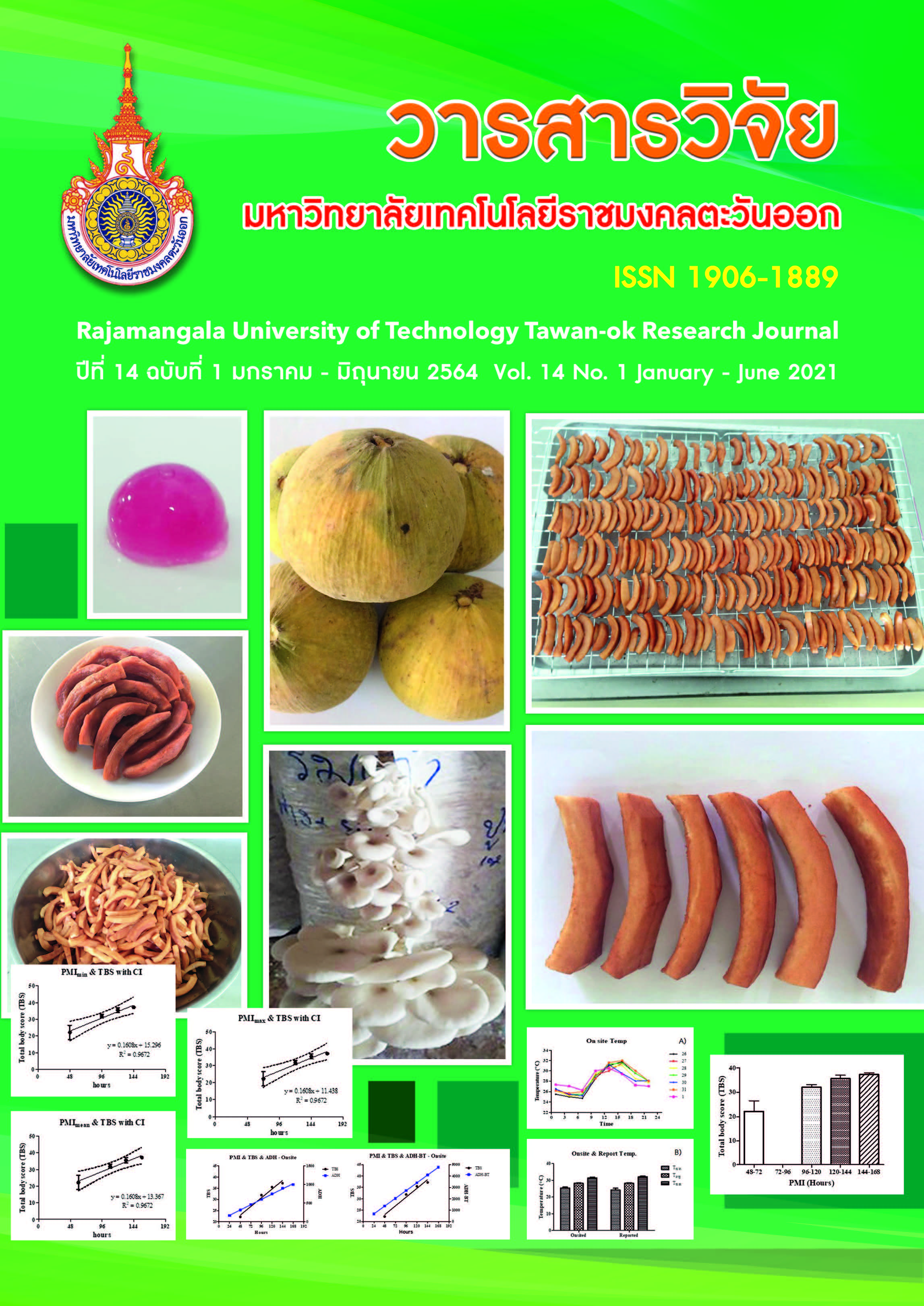Equation Model For Postmortem Interval Assessment From Ambient Temperature, Total Body Score And Time Since Death
Main Article Content
Abstract
Ambient temperatures factor affects the post-mortem changes. Forensic physicians canestimate the time of death by primarily examining post-mortem changes to the corpse. The objective of this research was to investigate the relationship of cumulative temperature change to total body score and mortality time of corpses. The results of the study can be used as a model for estimating mortality time in tropical Thailand. This research was a qualitative and documentary research based on secondary data. The study examined the relationship of cumulative temperature to the change in the total body score of the corpses and the time of death, based on a 48 total body change score. The results of the study of time after death, the low-mid-high margin postmortem
Article Details
References
Amendt, J., C. P. Campobasso, E. Gaudry, C. Reiter, H.N. LeBlanc and M.J.R. Hall. 2007. Best practice
in forensic entomology-standards and guidelines. Int J Legal Med. 121(2): 90-104.
Bass, W.M. 1997. Outdoor decomposition rates in Tennessee [in] forensic taphonomy: the postmortem fate of human remains in forensic taphonomy: the postmortem fate of human remains. CRC Press, Boca Raton, Florida.
Brown, C. and T. Peckmann. 2013. Decomposition rates and taphonomic changes associated with the estimation of time since death in a summer climate: a case study from urban Nova Scotia. Can Soc Forensic Sci. 46(4): 209-230.
Chockjamsai, M. 1999. Death and postmortem transformation. Department of Forensic Medicine, Faculty of Medicine, Chiang Mai, Chiang Mai. (in Thai)
Clark, M., M. Worrell and J. Pless. 1997. Postmortem Changes in soft tissues. In: Forensic taphonomy the postmortem fate of human remains. CRC Press, Boca Raton, Florida.
DiMaio, V. and D. DiMaio. 2001. Forensic Pathology. (Second edition ed.). CRC Press, Boca Raton, Florida.
Forbes, S. 2004. Time since death: a novel approach to dating skeletal remains. Aust J Forensic Sci. 36(2), 67-72.
Forbes, S. and K. Nugent. 2009. Dating of Anthropological Skeletal Remains of Forensic Interest in Handbook of Forensic Anthropology and Archaeology. Left Coast Press, Inc. Walnut Creek, California.
Galloway, A. 1997. The process of decomposition: a model from the Arizona-Sonoran desert. In: Forensic taphonomy the postmortem fate of human remains. The United States of America: CRC Press, Boca Raton, Florida.
Gruenthal, A. C. Moffatt and T. Simmons. 2012. Differential decomposition patterns in charred versus uncharred remains. J Forensic Sci. 57(1): 12-18.
Heaton, V. A. Lagden, C. Moffatt and T. Simmons. 2010. Predicting the postmortem submersion interval for human remains recovered from UK waterways. J Forensic Sci. 55(2): 301-307.
Klepinger, L.L. 2006. The Postmortem Period in Fundamentals of Forensic Anthropology. John Wiley and Sons, Inc. Koboken, New Jersey.
Mann, R., W. Bass and L. Meadows. 1990. Time since death and decomposition of the human body: variables and observations in case and experimental field studies. J Forensic Sci. 35(1): 103-111.
Marhoff, S.J. 2013. Using accumulated degree days and a degree of decomposition index to estimate the post-mortem interval of decomposing remains found in the Hawkesbury region: a porcine model (unpublished Honours thesis), in school of science and health. University of Western Sydney: Campbelltown Campus.
Megyesi, M.S. S.P. Nawrocki and N.H. Haskell. 2005. Using accumulated degree-days to estimate the
postmortem interval from decomposed human remains. J Forensic Sci. 50(3): 618-626.
Melina, L. 2010. Physical and chemical analysis of pig carcass decomposition in a fine sand. [unpublished Master’s thesis on the internet]. Ontario, Canada: University of Ontario Institute of Technology, Retrieved from http://hdl.handle.net/10155/115
Moffatt, C. T. Simmons and J. Lynch-Aird. 2016. An improved equation for TBS and ADD: establishing a reliable postmortem interval framework for casework and experimental studies. J Forensic Sci. 61(S1): S201-207.
Myburgh, J., E. L’Abbé and M. Steyn. 2013. Estimating the post-mortem interval using accumulated degree-days in a South African setting. Forensic Sci Int. 229: 165e.161-166.
Parks, C. 2011. A study of the human decomposition sequence in Central Texas. J Forensic Sci. 56(1): 19-22.
Pickering, R.B. and D. Bachman. 2009. Determination of time since death, in the use of forensic anthropology. CRC Press Taylor and Francis Group: Boca Raton, Florida.
Rodriguez, W. and W. Bass. 1983. Insect activity and its relationship to decay rates of human cadavers in East Tennessee. J Forensic Sci. 28(2): 423-432.
Suckling, J.K., M.K. Spradley and K. Godde. 2016. A longitudinal study on human outdoor decomposition in Central Texas. J Forensic Sci. 61(1): 19-25.
Van Daalen, M.A., D.S. De Kat, B.F. Oude Grotebevelsborg, R. De Leeuwe, J. Warnaar, R.J. Oostra and
W.L.J.M. Duijst-Heesters. 2017. An aquatic decomposition scoring method to potentially predict the postmortem submersion interval of bodies recovered from the North sea. J Forensic Sci. 62(2): 369-373.
Wattanakhajorn, T. and U. Hunwijit. 1999. Death, change after death and estimating time of death. Bangkok: Chulalongkorn University Printing House. (in Thai)
Wilson-Taylor, R.J. and A.M. Dautartas. 2013. Time since death estimation and bone weathering, in Forensic Anthropology: An Introduction. CRC Press Taylor and Francis Group: Boca Raton, Florida.


